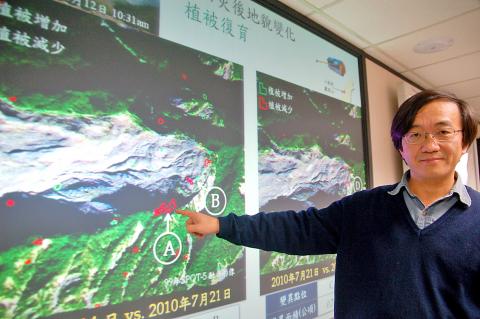Remote sensing scientist Chen Kun-shan (陳錕山) was not involved in any sensitive research projects in Taiwan before he defected to China, the Ministry of National Defense said yesterday.
Chen, head of the Center for Space and Remote Sensing Research at National Central University (NCU) since 2001, disappeared in September last year. He is now working at China’s State Key Laboratory of Remote Sensing Science under Beijing’s high-profile “Thousand Talents Program,” which seeks to attract overseas scientists.
In a front-page story yesterday, the Chinese-language Liberty Times (the Taipei Times’ sister newspaper) cited an intelligence source as saying that Chen’s defection posed a “serious threat” to Taiwan’s national security.

Photo: Hsieh Wen-hua, Taipei Times
As head of the center, Chen had access to satellite images covering Taiwan and China’s military deployments, and was in a category of government employees with access to state secrets and restricted from visiting China, the report said.
However, Ministry of Defense spokesman Major General David Lo (羅紹和) yesterday said that Chen had undertaken research projects commissioned by the Chung-Shan Institute of Science and Technology (CSIST, 中山科學研究院) and the ministry’s Communications Development Office, all of which were academic in nature and unrelated to key military technologies.
Meanwhile, Ministry of Education Secretary-General Wang Tsuo-tai (王作台) said that Chen was suspended by the university in November last year, two months after he went absent without leave.
Wang said the university learned through Chinese media reports in March that Chen had been hired to work at State Key Laboratory of Remote Sensing Science.
The reports were later verified with Beijing through the Mainland Affairs Council, he added.
The university confirmed yesterday that it had decided on April 7 to dismiss Chen and had submitted his case to the Ministry of Education for final approval.
Kainan University vice president David Huang (黃適卓) yesterday lambasted Minister of Education Chiang Wei-ling (蔣偉寧), accusing the education ministry of failing to implement proper preventive mechanisms on cross-strait academic interaction.
Huang said Chiang should take full responsibility for what he described as a “national security fiasco” and step down, as Chuang had been instrumental in promoting the disloyal Chen to his position at the NCU center.
Huang said China has long coveted Taiwanese technology and has been using the guise of academic interaction to implement its “united front” rhetoric.
Huang said that China is still absorbing what it can of Taiwan’s academic research, especially in nanotechnology, agricultural sciences and husbandry, and information technology, in which Taiwan has made significant advances.
Cooperation between academia and the military has a long history, and many military projects have sought the participation of educators, Huang said, adding that these professors have been targeted by Chinese intelligence for contact.
Before both sides of the Taiwan Strait agreed to academic exchanges, contacting Taiwanese academics had been the job of Taiwanese businesspeople in China, Huang said, adding that after academic exchanges were approved, China has used that channel to contact educators directly.

The US government has signed defense cooperation agreements with Japan and the Philippines to boost the deterrence capabilities of countries in the first island chain, a report by the National Security Bureau (NSB) showed. The main countries on the first island chain include the two nations and Taiwan. The bureau is to present the report at a meeting of the legislature’s Foreign Affairs and National Defense Committee tomorrow. The US military has deployed Typhon missile systems to Japan’s Yamaguchi Prefecture and Zambales province in the Philippines during their joint military exercises. It has also installed NMESIS anti-ship systems in Japan’s Okinawa

‘WIN-WIN’: The Philippines, and central and eastern European countries are important potential drone cooperation partners, Minister of Foreign Affairs Lin Chia-lung said Minister of Foreign Affairs Lin Chia-lung (林佳龍) in an interview published yesterday confirmed that there are joint ventures between Taiwan and Poland in the drone industry. Lin made the remark in an exclusive interview with the Chinese-language Liberty Times (the Taipei Times’ sister paper). The government-backed Taiwan Excellence Drone International Business Opportunities Alliance and the Polish Chamber of Unmanned Systems on Wednesday last week signed a memorandum of understanding in Poland to develop a “non-China” supply chain for drones and work together on key technologies. Asked if Taiwan prioritized Poland among central and eastern European countries in drone collaboration, Lin

BACK TO WORK? Prosecutors said they are considering filing an appeal, while the Hsinchu City Government said it has applied for Ann Kao’s reinstatement as mayor The High Court yesterday found suspended Hsinchu mayor Ann Kao (高虹安) not guilty of embezzling assistant fees, reducing her sentence to six months in prison commutable to a fine from seven years and four months. The verdict acquitted Kao of the corruption charge, but found her guilty of causing a public official to commit document forgery. The High Prosecutors’ Office said it is reviewing the ruling and considering whether to file an appeal. The Taipei District Court in July last year sentenced Kao to seven years and four months in prison, along with a four-year deprivation of civil rights, for contravening the Anti-Corruption

NO CONFIDENCE MOTION? The premier said that being toppled by the legislature for defending the Constitution would be a democratic badge of honor for him Premier Cho Jung-tai (卓榮泰) yesterday announced that the Cabinet would not countersign the amendments to the local revenue-sharing law passed by the Legislative Yuan last month. Cho said the decision not to countersign the amendments to the Act Governing the Allocation of Government Revenues and Expenditures (財政收支劃分法) was made in accordance with the Constitution. “The decision aims to safeguard our Constitution,” he said. The Constitution stipulates the president shall, in accordance with law, promulgate laws and issue mandates with the countersignature of the head of the Executive Yuan, or with the countersignatures of both the head of the Executive Yuan and ministers or